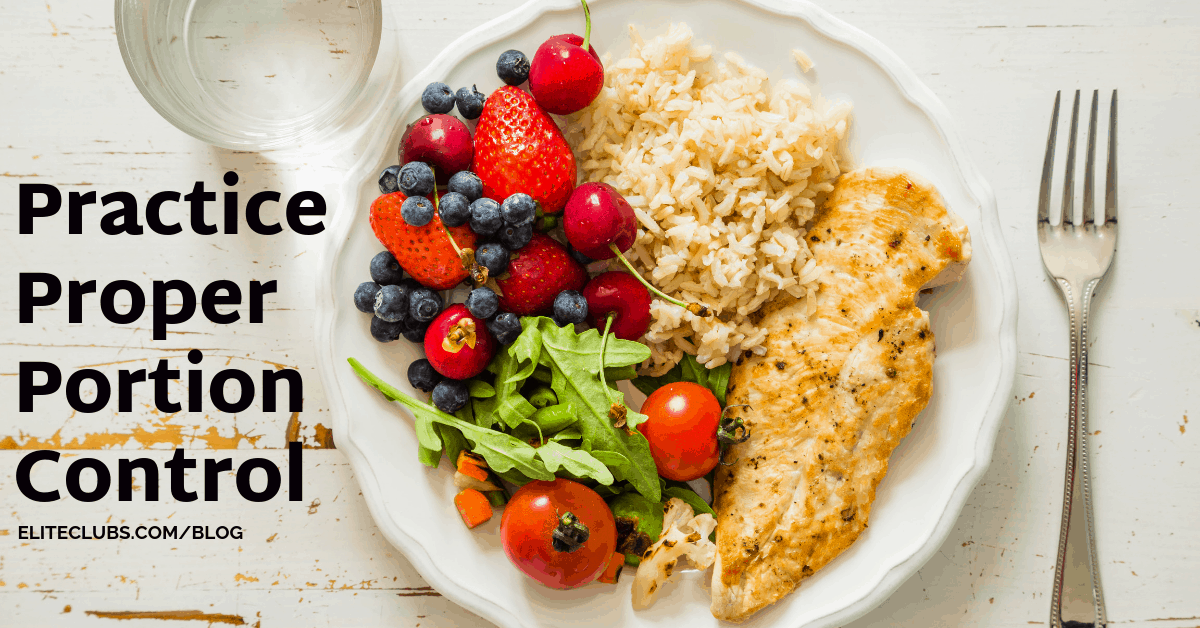
Most adults may have noticed that food portions have gotten larger, not only in restaurants but at home as well. In the age where you can super-size almost anything, many meals have become enough food for at least two people. With this growth in portion size comes an increase in the average person’s waistline and body weight. Follow these guidelines to learn how to prevent weight gain from these current excessive portions.
Tips for Proper Portion Sizes
- Legumes
- Legumes include beans and lentils. The proper portion size of legumes is about
the size of a tennis ball. This is equal to 1/2 cup beans or lentils, or 1/4 cup hummus.
- Legumes include beans and lentils. The proper portion size of legumes is about
- Vegetables
- Vegetables are every vegetable except beets, carrots, squash, potatoes, and sweet potatoes. The proper portion size of vegetables is about the size of a lightbulb. This is equal to 1/2 cup cooked or 1 cup raw vegetables.
- High Glycemic Vegetables
- High glycemic vegetables are those that are higher in starch and therefore sugar.
These include beets, carrots, squash, potatoes, and sweet potatoes. The proper portion size of high glycemic vegetables is about the size of a computer mouse. This is equal to 1/2 cup cooked beets, carrots, squash; 1/2 medium potato or sweet potato; or 12 raw baby carrots.
- High glycemic vegetables are those that are higher in starch and therefore sugar.
- Protein
- Protein includes both plant and animal sources such as tofu, dairy, and lean
meats. The proper portion size of protein is about the size of a deck of cards. This is equal to 3-4 oz. fish, chicken, turkey, lean meat; 2 whole eggs; 3/4 cup cottage cheese; 4 oz. veggie burger; 1 cup fresh tofu; or 3/4 cup cooked tofu.
- Protein includes both plant and animal sources such as tofu, dairy, and lean
- Fruit
- Fruit includes all sources such as fresh, frozen, dried and dehydrated. The proper
portion size of fruit is about the size of a tennis ball. This is equal to 1/2 cup fruit; 1
medium piece of fruit; 1 cup berries; or 2-3 Tbsp. dried fruit.
- Fruit includes all sources such as fresh, frozen, dried and dehydrated. The proper
- Dairy
- Dairy includes all sources such as yogurt, milk, cheese and cottage cheese. The proper portion size of dairy is about the size of 2 dice. This is equal to 1 cup milk or plain Greek yogurt; 1 string cheese; 1/2 cup cottage cheese or 1 oz of shredded cheese.
- Nuts and Seeds
- Nuts and seeds include all versions as long as they are unsalted and unflavored.
The proper portion size of nuts and seeds is about the size of a golf ball. This is
equal to 2 Tbsp. nuts or seeds or 1 Tbsp. nut butter.
- Nuts and seeds include all versions as long as they are unsalted and unflavored.
- Oils and Fats
- Oils and fats include those we use as dressings, condiments and cooking. The proper portion size of oils and fats is about the size of 2 dice. This is equal to 1
tsp. Oil; 1 tsp. Butter; 1 tsp. Mayonnaise; 1 Tbsp. vinegar and oil salad dressing;
8-10 olives; or 1/8 avocado.
- Oils and fats include those we use as dressings, condiments and cooking. The proper portion size of oils and fats is about the size of 2 dice. This is equal to 1
- Grains
- Grains include pasta, bread, crackers, rice, and cereal. The proper portion size of grains is about the size of a baseball. This is equal to 1/2 cup whole wheat pasta; 1/2 cup quinoa, barley, buckwheat, bulgur; 1/3 cup brown or wild rice; 1 slice 100% whole grain bread; 1 whole grain tortilla; 3/4 cup whole grain cereal; 1/2 cup cooked steel cut oats; or 3-6 whole grain crackers.
Another way to watch your portion sizes is to choose a smaller plate. When we choose a large plate, we tend to fill them up. A smaller plate forces you to eat less at a time, and even if you choose to eat more, you’ll still eat slower and feel fuller. Follow the MyPlate food guidelines to further help you on how to fill your plate with certain food groups.
Getting a grip on portion control will help you watch your calorie intake. If you need some additional help with healthy eating, come see me for a free nutrition consultation!
Schedule a Nutrition ConsultationWritten by Sarah Brunner, RDN, CD; former Elite Sports Clubs Registered Dietitian
Sarah is certified in food allergies/intolerances and nutritional counseling, Academy of Nutrition and Dietetics; has a certificate in Dietetics from Mount Mary University; and a BA in Education and Mathematics from the University of Wisconsin – La Crosse.
